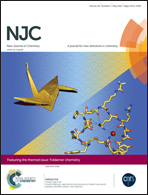Substituent effects in solution speciation of the mononuclear and dinuclear trimethylplatinum(iv) iodide complexes of pyridines†
Abstract
A series of mononuclear trimethylplatinum(IV) complexes, [PtMe3L2I] [L = 4-cyanopyridine (4-NCpy), 4-methoxypyridine (4-MeOpy), 4-methylpyridine (4-Mepy), 4-ethylpyridine (4-Etpy), 4-tbutylpyridine (4-tBupy) and 4-dimethylaminopyridine (4-Me2Npy)] have been synthesized in good yield via a series of reactions of trimethylplatinum(IV) iodide with excess pyridine ligands (L) in chloroform. The synthesized mononuclear [PtMe3L2I] complexes on treatment with [(PtMe3I)4] in equimolar ratio result in the formation of syn- and anti-forms of iodo bridged dinuclear complexes [PtMe3LI]2 in chloroform. The complexes were characterized using proton nuclear magnetic resonance spectroscopy. Population of the mononuclear and dinuclear forms in solution depends on the electronic effect as well as on the steric influences of the pyridine substituents. The formation of the dinuclear complexes in solution was confirmed using X-ray crystal structure determination of anti-[PtMe3(4-NCpy)I]2, syn-[PtMe3(4-NCpy)I]2, syn-[PtMe3(4-MeOpy)I]2 and syn-[PtMe3(4-Etpy)I]2. The X-ray structural analysis of the complexes confirms that the two bridging iodine atoms hold the two platinum metal centers together, giving an edge sharing bi-octahedral structure. Furthermore, the crystal structures of the three mononuclear complexes [PtMe3L2I] (L = 4-NCpy, 4-Mepy and 4-Etpy) were also investigated in this research.


 Please wait while we load your content...
Please wait while we load your content...